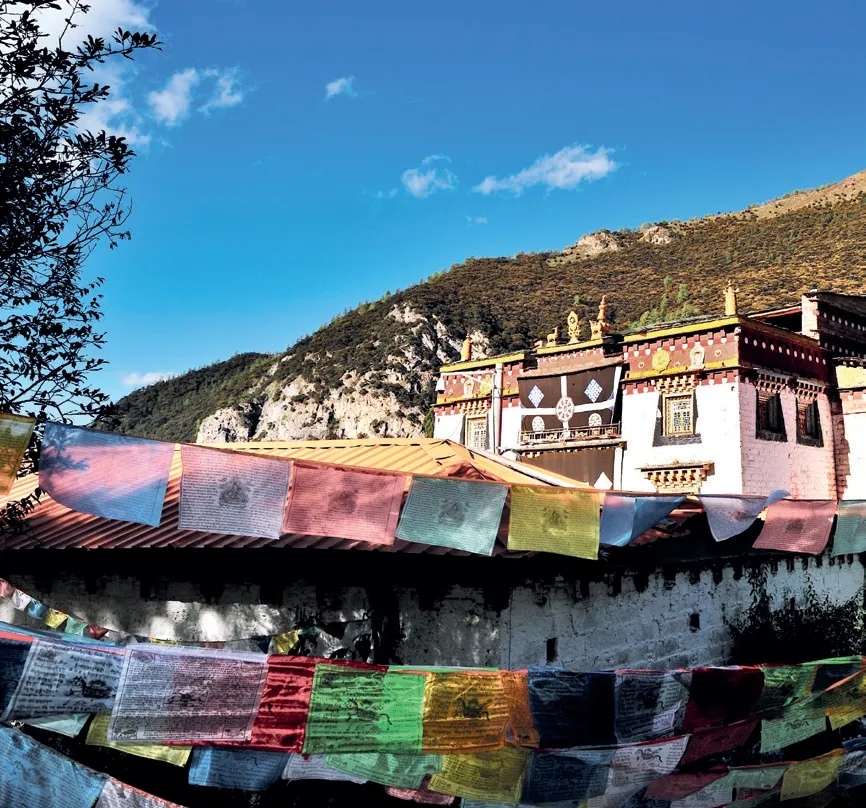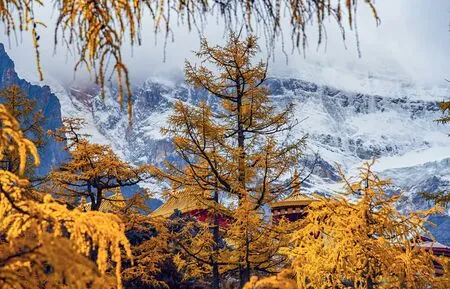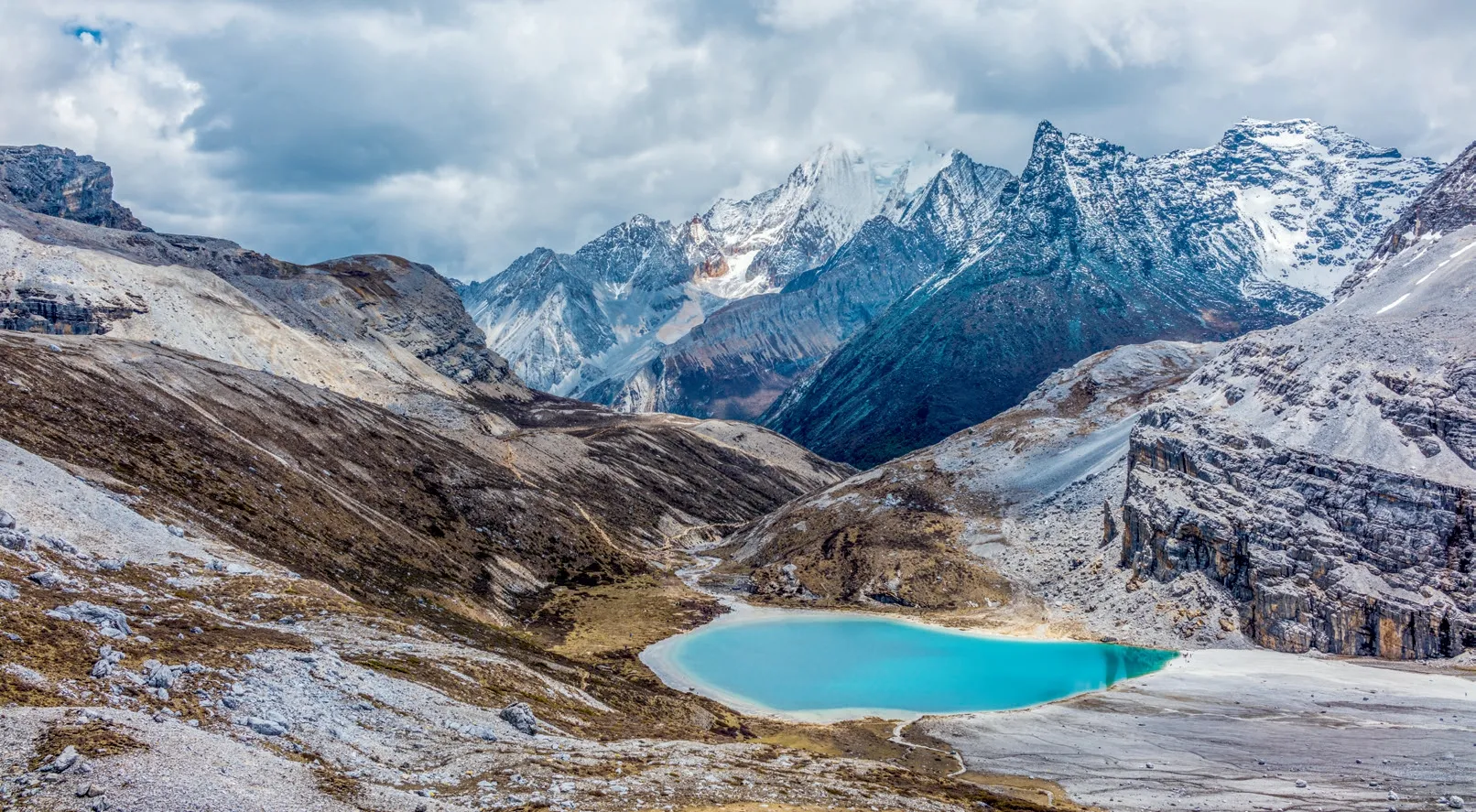Yading:Nature’s Purity Guarded by Sacred Mountains
By staff reporter MENG JIAXIN
A remote place nestled in the Tibetan Plateau where one can enjoy all the high-altitude landscapes and visit an 800-year-old Buddhist temple.
IN the remote mid-Hengduan Mountain Range of eastern Tibetan Plateau lies a sacred place that has been worshipped by Tibetan Buddhists for more than eight centuries. The area features towering snow-capped mountains, flat and vast meadows, as well as ravines and crystal clear lakes. The Tibetans call it “Nianqing Gongga Risong Gongbu,” meaning “a holy land guarded by three holy mountains covered with snow all year around.” Today, located in Daocheng County, Garze Tibetan Autonomous Prefecture of Sichuan Province in southwestern China, the area’s Yading National Nature Reserve, and Daocheng Yading Scenic Area are open to the public.

A stunning reflection of the Youmayon’s snow peaks on the still waters below can be seen in Yading Scenic Area of Daocheng County, Garze Tibetan Autonomous Prefecture of Sichuan Province in southwestern China.
Yading was not known to the world until 1928, when American botanist and explorer Joseph Locke came across the area in his travels, describing the stunning landscape in articles and photographs published inNational Geographic. The exposure gained the mountain region global attention,inspiring British author James Hilton to write the bestselling 1933 adventure novelLost Horizon, a story of a Tibetan utopian village known as Shangri-la.The book made this mysterious part of the world even more well-known.
The Yading Scenic Area is a typical alpine valley, with an elevation of 2,900 meters to 6,023 meters above sea level.Stretching 1,344 square kilometers,Yading has one of the most complete and primeval alpine natural ecosystems in China, with the most unique snow mountain landscapes. These include a forest ecosystem, alpine lakes,glacier valleys, plateau ravines, gorges,and meadows. Besides, its biological diversity is like no other in the Hengduan Mountains. In 2001, Yading National Nature Reserve was established, and on July 10, 2003, Yading was included in UNESCO’s World Network of Biosphere Reserves.
The nature reserve is mainly composed of the three sacred mountains,Xiannairi, Youmayon, and Xanoda and the surrounding rivers, lakes, and alpine meadows. With its scenic beauty,it is a paradise for hikers and photographers.
Three Sacred Mountains
The three sacred mountains are regarded as the guardians of the Tibetan people in Yading. The locations of these snow-capped mountains form a triangle.During the eighth century, a Buddhist master consecrated the three snow peaks and named them after the three lords of Buddhism. They are therefore also known as the Three Lords Snow Mountains.
Xiannairi, which means Guanyin Bodhisattva in the Tibetan language, is the north peak of the three sacred mountains. With an elevation of 6,032 meters above sea level,it is the highest peak in Daocheng,and the fifth highest peak in Sichuan Province. It is 10 degrees to the north, pointing at the Big Dipper in the west, which is regarded in Buddhism as the star of good fortune.
At an altitude of 5,958 meters,Xanoda is the eastern peak of theThree Lords Snow Mountains. Xanoda, meaning Vajrapani Bodhisattva in Tibetan, is a protector and guide of Buddha. Locke described it as,“A truncated pyramid flanked by broad buttresses like the wings of a stupendous bat.” Of the three mountains, Xanoda is made of layered marble, and the strong geological agents have sharpened the rock upright, which is one of the reasons for Xanoda’s bizarre and sharp peaks.There is a vast glacier gorge at the foot of the mountain, where upright rock layers stretch out to the top of the peak, and the folds between the rock layers are discernible to the naked eye. Below the peak are screes formed by glacial collapse, and further down are alpine shrubs and forest.
The southern peak of the trio is Youmayon, 5,958 meters above sea level. Tibetans call it as Manjushri Bodhisattva. For Buddhists,Manjushri is the embodiment of wisdom, and the snowy peak of Youmayon is like the sword wielded by Manjushri, straight up into the sky.There is also a spring flowing down from the mountain, which forms a magnificent waterfall.

The Chonggu Temple in Yading.
Three Sacred Lakes
Yading also has three sacred lakes: the Milk Lake, the Five-Color Lake, and the Pearl Lake.
The Milk Lake, about 4,500 meters above sea level, is located in a col at the foot of Youmayon.Surrounded by mountains, it is rimmed by a milky white band,after which it was given the name.The varying depths under the water create multiple colors for the lake. With the sediments of the remains of old plants, the water near the shore is a bit blackish.Another rim closer to the center is light green, and the further rims are greener still and the water crystal clear. Surrounding the lake are alpine meadows and snowcapped mountains and glaciers, a perfect spot for lovers of landscape photography.
Not far from the Milk Lake is the Five-Color Lake. With an area of 0.7 hectares, it is the highest lake in Yading, about 4,600 meters above sea level. It was named because of the various shades of water produced in sunlight. The distinct lake colors from near the bank to the center of the lake are light blue, dark blue and dark green. For Tibetans, it is said that the lake can “relive the history and foretell the future,” and Buddhist monks and priests often carry out divination there. Since ancient times, pilgrims coming to worship the three main sacred mountains also stop at the Five-Color Lake,hoping that the sacred lake could give them some future inspiration.
Legend has it that the Pearl Lake is the soul lake of White Tara,the goddess Tibetans pray to for healing and longevity. Located at the foot of the Xiannairi Mountain,the lake is recognized as the best place to photograph the reflection of Xiannairi. This green lake looks like a natural emerald lovingly crafted by nature and delicately placed on the earth.

Autum in Yading.
Luorong Cattle Farm
In the middle of the three snowy mountains there is an open and flat alpine meadow. It is a pasture for the nearby Tibetans to graze their livestock, so is known by the locals as Luorong Cattle Farm. This is a high-altitude pasture, 4,150 meters above sea level, nestled in the arms of three sacred mountains. This is the most ideal place to view the three snow-capped mountains.
This alpine cattle farm is an observation deck from which people can view nearly the entire landscape of the plateau: meadows,yaks, snow-capped mountains,ravines, a Tibetan village, and a Buddhist temple. The Gongga River runs through the meadow, where herds of cattle and sheep soak up the sun. People here worship nature and live in harmony with it.
In spring and summer, when wild flowers bloom across the meadows, the cattle farm is transformed into a floral kingdom. The farm is on the route to the Five-Color Lake and Milk Lake, so it is a must-see spot.
Chonggu Temple
Chonggu is the temple that inspired Hilton’s Shangri-La Temple inLost Horizon.
At the foot of Mount Xiannairi,the lone Chonggu Temple stands at an altitude of 3,880 meters. Its name means “the temple at the source of the lake” in Tibetan. Dating back eight centuries, Chonggu Temple is a Gelug sect temple.

Thick clouds roll across the vast skies over the Milk Lake in Yading.
In 1928, Locke came to Yading and stayed at the Chonggu Temple for three days. He then wrote a detailed description of the monastery, which provided clues for the Shangri-La Lama Monastery inLost Horizon.
In the past century, the monastery was badly damaged but after a major renovation it was restored. With the blue sky and snow-capped mountain as the backdrop, the temple’s white walls and golden roofs look enchanting and serene. With prayer flags fluttering in the wind, under the guardianship of the three sacred mountains, devotees dressed in
Tibetan Buddhist robes continue the chanting that has been heard at the temple for the past 800 years.

